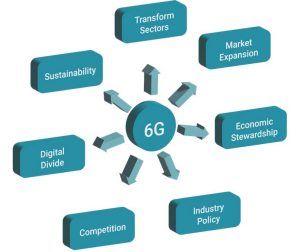6G – Why Start Now?
By incorporating distributed computing and advanced sensing, 6G will extend the envelope of our communications technology enabling massive leaps forward in multiple industries’ technical capabilities. New applications will also be possible — for both businesses and for use in everyday life. Thus, 6G innovation will have far-reaching economic and social impact. Through ATIS’ Next G Alliance (NGA), industry is taking a new approach in creating the 6G future. While previous generations of wireless were defined as technological improvements on prior generations, 6G is being defined by what individuals, innovators and societies
need.
While commercial 6G networks are expected to be operating by 2030, the information and communications technology industry, all technology-driven industries, government, and academia must start working now to shape the 6G future. The work to prompt this collaboration and to shape 6G’s vision, standards and market is taking place now through NGA. With a time horizon that extends beyond 2030 to encompass the 6G and beyond future, the NGA is prompting immediate proactive, strategic and cooperative action today to ensure North America is a leader in the 6G future. 6G Market Development: A North American Perspective sets forth three imperatives to help us get there.
6G’s Far-Reaching Economic Impacts
 In its broadest sense, 6G is set to be at the center of everyday living. That means non-technical requirements will add to 6G’s scope. This heightens the need for commercial, academic, and political leadership to secure North America’s interests and the continent’s international role. 6G’s connectivity, multi-sensory interfaces and immersive content will enable novel physical and digital world interactions with immense potential to transform almost every industry. Educators will teach through highly immersive remote education; 6G-network-enabled robotics and autonomous systems will be used in health care and home care; and the training and defense sectors will use high-fidelity, ambient tactile simulators. And, at an overall level, communications carriers and enterprises will deploy more secure communications networks.
In its broadest sense, 6G is set to be at the center of everyday living. That means non-technical requirements will add to 6G’s scope. This heightens the need for commercial, academic, and political leadership to secure North America’s interests and the continent’s international role. 6G’s connectivity, multi-sensory interfaces and immersive content will enable novel physical and digital world interactions with immense potential to transform almost every industry. Educators will teach through highly immersive remote education; 6G-network-enabled robotics and autonomous systems will be used in health care and home care; and the training and defense sectors will use high-fidelity, ambient tactile simulators. And, at an overall level, communications carriers and enterprises will deploy more secure communications networks.
6G will also expand economic opportunities. There will be new frontiers for the research, intellectual property, and investor communities. 6G’s software paradigm will stimulate the wider software sector while boosting innovation in content development and collaborative working. Further, national economic security requires dependable access to technology and secure supply chains. This will apply to the future where 6G is the universal fabric for computing, communications, and sensing.
The Lead Time to Influence Market Development is Narrowing
Across the world, governments and corporations are launching pre-emptive initiatives to steer 6G research priorities. If 6G follows the evolution of 5G and 4G, we can expect commercial 6G systems to be in place in 2030; prototypes and trials from leading nations and vendors will start around 2026. However, the lead time to attain market leadership is narrowing. With acceleration of the convergence of information technology with communication technology, the 6G timeline is also accelerating.
 The process for launching a new “G,” or generation of communications technology, customarily begins with a vision and research prioritization activity. This takes cooperation among industry, academia, and government. While formal standards work is still a couple years off, the vision for 6G is being set within both the International Telecommunication Union (ITU) as well as several regional efforts globally, most with significant government financial and resource support intended to drive the next wave of technology investment toward their respective regions. The visioning process leads to a technical standardization phase, involving the 3rd Generation Partnership Project (3GPP) among other bodies. 3GPP encompasses several regional standards organizations. ATIS – The Alliance for Telecommunications Industry Solutions is 3GPP’s North American Organizational Partner. The 6G and beyond work of the Next G Alliance takes place under the auspices of ATIS, thus advancing and aligning North American priorities with the global standards body.
The process for launching a new “G,” or generation of communications technology, customarily begins with a vision and research prioritization activity. This takes cooperation among industry, academia, and government. While formal standards work is still a couple years off, the vision for 6G is being set within both the International Telecommunication Union (ITU) as well as several regional efforts globally, most with significant government financial and resource support intended to drive the next wave of technology investment toward their respective regions. The visioning process leads to a technical standardization phase, involving the 3rd Generation Partnership Project (3GPP) among other bodies. 3GPP encompasses several regional standards organizations. ATIS – The Alliance for Telecommunications Industry Solutions is 3GPP’s North American Organizational Partner. The 6G and beyond work of the Next G Alliance takes place under the auspices of ATIS, thus advancing and aligning North American priorities with the global standards body.
Advancing North American Imperatives
North American leadership can shape the direction of 6G today by building on the continent’s economic dynamism, unique industry-driven business models, and technical strengths. Three imperatives will help get us there:
The first requires stakeholders in North America to act immediately on 6G. 2030 is eight years away but planning and mobilization take time. Other regions of the world have launched 6G research and pre-standardization efforts. They have plans for government funding and private-sector incentives to position themselves as 6G market leaders and advance their respective industries. North American success depends on overlaying a bottom-up vision, led by the private sector, with top-down political action. Academia and the private sector have launched the NGA to take immediate action. To succeed, it will be critical to align common interests and coordinate with different branches of government. In today’s challenging environment, any delay in North American innovation poses risks to North American 6G leadership and may also result in social and economic impacts.
The second imperative is to invest in collaboration and reduce sources of friction. North America should take a holistic approach by mapping early investments in 6G research and development to longer-term goals in education, healthcare, transportation, agriculture, and the many other sectors that are fundamental to achieving crucial economic and societal outcomes by the end of this decade. Specific measures include shorter intervals to discover and secure research funding as well as earlier engagement between information and communications technology (ICT) and non-ICT sectors to plan for digital economy solutions while simultaneously capturing emerging requirements. Steps to guide the academic curriculum will inspire students to pursue careers in STEM fields related to 6G and develop North America’s future workforce.
A third imperative is to leverage the power of government to drive 6G deployment and adoption. Federal and local governments can commit to 6G through policies that carry the technology from research to commercialization. Improved regulatory permitting and preparation of market-ready spectrum policies will enable affordable access to 6G. Government agencies can also work with like-minded nations to prepare for issues linked to digital-world property rights and the responsible use of data and technology.
6G will be much larger than the next “G” or the next generation of technological advancements. It will succeed in delivering North American leadership through aligning government policies with technology innovation and its applications, and research needs — with a focus on society’s uses for technology and its implications. The journey must begin now by aligning the combined power of North American government, industry, and academia to achieve 6G market leadership and advance the values that North America represents.

